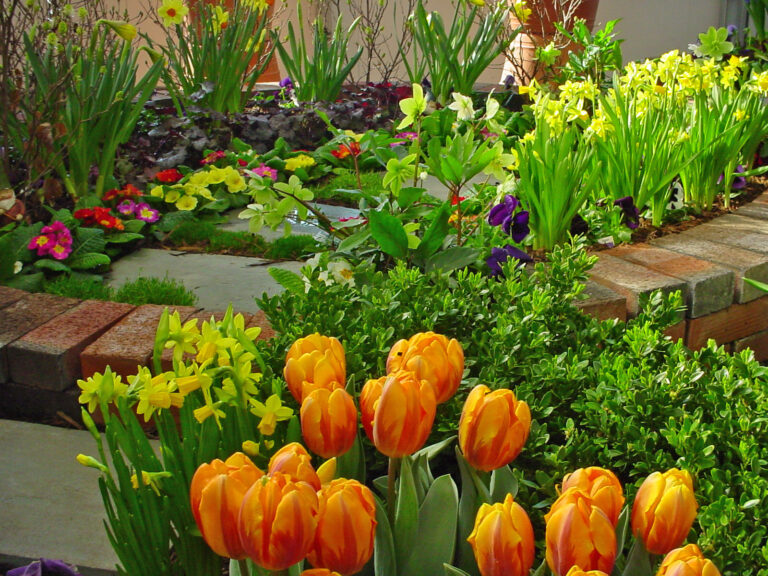Spring Flowering Bulbs

Bulb Varieties & Planting Tips
Ward’s offers many Spring-flowering bulbs for Fall planting. Bulbs bring early color before trees leaf out and the bulbs benefit from the dry soil as the tree starts drawing water in earnest through the growing season. Read on to see the options available. Those that are pest-resistant are marked ‘PR’. Printable PDF version of full post
Bulbs good for naturalizing
-
- Daffodils (PR) or Narcissus. Virtually ignored by deer, voles and other rodents; Narcissus come in a variety of shapes, colors and sizes that will bloom in stages for months. When you plant a deciduous specimen tree or shrub, include a ring of daffodils or any of the following bulb varieties for a pretty early show.
- Galanthus or Snowdrops (PR), Crocus, and Scilla (PR). All these small bulbs show up in very early to early spring. Plant these in groups right under your grass. Cut away an area of sod and peel it back. Arrange the bulbs in the proper spacing and replace the sod. Water well. These bulbs will bloom and be dying back before your grass needs mowing in the spring.
- Camassia or Wild Hyacinth. A native bulb to North America, the multi-flower stems emerge in early summer and range in color from pale lilac to deep blue. Will naturalize and spread.
- Leucojum (PR). Known as Spring and/or Summer snowflake, the nodding white bell type flowers emerge in March (for L. vernum) and April (for L. aestivum). Height ranges from 1 to 1.5 feet.
- Puschkinia or Striped Squill produces 3-6 star-shaped blooms of pale blue per stem in early spring, reaching about 4-6 inches tall.
- Muscari (PR) or Grape hyacinths look like inverted grape bunches in deep royal blue with white edges. They naturalize easily. If blooms fail to appear, it’s time to dig up and divide clumps. Grow 6 – 8 inches tall.
- Colchicum – Known as Fall-blooming Crocus because the pink and white, crocus-like blooms emerge now. In contrast to other bulbs, the foliage doesn’t appear until spring then dies back as blooms emerge.
- Chionodoxa (PR) flower in multiple blooms from one bulb and emerge in March and April. Plant these in outdoor planters or around rock outcroppings and along the edges of perennial beds for a bright early show of blues, purples and pinks.
Bulbs or Tubers Available to Add or Divide in Fall
To keep the following bulbs blooming, be sure to fertilize in spring. Even then, some of these may stop blooming after a few years and need to be replaced or divided.
-
- Tulips and Hyacinths (PR) have an elegance that’s hard to resist. Fertilize their locations through the growing season to keep them performing for you. Also to keep pests at bay, use repellants on Tulips at planting time or encase them in a mesh box or mesh onion bag that will frustrate those small and large rodents. Ward’s has instructions for making your own mesh Bulb Cage. (see more below)
- Garlic (PR) and Fritillaria (PR) will also serve as pungent repellent bulbs. Plant these small and large bulbs around bulbs or plants that are regularly plagued by underground rodents. (And you’ll have the garlic to harvest in August!)
- Allium (PR) and Iris are also available now. Allium’s small to massive globes of blooms add a dramatic and unusual shape to your June garden. If creating a layered display, the allium can be planted first and deepest. When planting Iris tubers, give them some room and plant just below the soil surface.
Tips for Outdoor Planting
-
- To plant a layered bulb garden, plant larger bulbs the deepest. Smaller bulbs usually bloom first; larger bulbs bloom the latest. Miniature narcissus prove to be the exception; they bloom later than full size daffodils.
- For more specific bloom time information, click Bulb Bloom Times
- Daylilies can finish the planting and their long leaves will mask the die-back of the early bulbs.
- If the bulbs you wish to grow are delectable to garden pests– like anemone, hyacinth or tulips, try planting them in clusters within a bulb cage. Instructions to Make a Bulb Cage
Try Forcing Bulbs into Bloom Indoors
-
- Spring flowering bulbs need 12 to 15 weeks at temperatures between 41-48°F to produce roots and successfully flower. This can be accomplished in an extra refrigerator or cold garage.
- A detailed instruction sheet in PDF form can be found by clicking> Forcing Bulbs
- And bulb chill times can be found by clicking> Bulb Chilling Times for Indoor Forcing.
Spring Gardening Tips
The garden is waking up, and you're in charge! It's time to start planting, pruning, and preparing your flower beds.
Spring Articles